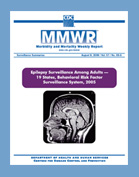 |
|
 |
 |
 |


One of the Nation's Most Common Disabling Neurological Conditions
Epilepsy is a general term that includes various types of seizures.
People with diagnosed epilepsy have had more than one seizure, and they
may have had more than one kind of seizure. A seizure happens when
abnormal electrical activity in the brain causes an involuntary change in
body movement or function, sensation, awareness, or behavior.
Epilepsy affects about 2.5 million Americans, and results in an
estimated annual cost of $15.5 billion in medical costs and lost or
reduced earnings and production. People of all ages are affected, but
particularly the very young and the elderly. About 10% of Americans will
experience a seizure sometime during their lifetime, and about 3% will
have had a diagnosis of epilepsy by age 80.
The first national conference on public health and epilepsy, Living
Well with Epilepsy I, convened in 1997. The conference was co-sponsored by
CDC, the American Epilepsy Society (AES), the National Association of
Epilepsy Centers (NAEC), and the Epilepsy Foundation (EF). This conference
defined the aim of epilepsy treatment as "no seizures, no side effects."
Its key messages can be summarized as: "take seizures seriously, do it
early, do it right the first time, be systematic, efficient and effective,
and empower the patient."
Participants collaborated on developing a list of priority epilepsy
concerns ranging from researching the evaluation and care of patients
having a first seizure to combating stigmatization and reducing
disabilities associated with epilepsy. This list of priority concerns was
the impetus for developing CDC epilepsy programs directed at improving
care; improving communication and combating stigma; self-management;
surveillance and prevention research; increasing public awareness and
knowledge about epilepsy; and strengthening partnerships.
Living Well
with Epilepsy II, held on July 30-31, 2003, was co-sponsored by CDC, AES,
NAEC, EF, and the Chronic Disease Directors. The aim of this conference
was to review progress since Living Well with Epilepsy I, and to recommend
priorities for a public health agenda on epilepsy for the next 5 years,
focusing on early recognition, diagnosis, and treatment; epidemiology and
surveillance; self-management; and quality of life. An additional aim was
to identify other needs and challenges that might be addressed by the
epilepsy community and those who support it. Examples of CDC activities include those listed under
Program Activities.
Key Public Health Issues
- The goal of eliminating seizures, while at the same time preventing
side effects from treatment, is achievable for most people with
epilepsy. However, most areas of the country do not have the organized
systems of care necessary to provide needed service, and support for all
people with epilepsy.
- Epidemiological and surveillance data on epilepsy are limited. More
research is needed on epilepsy, in particular on how the causes,
frequency, and severity of the condition differ among age groups, races,
and communities.
- People with epilepsy often struggle to overcome low self-esteem and
the stigma that is attached to having epilepsy. The stigma is due in
part to a lack of understanding by people they see every day — family
members, schoolmates, colleagues. Some people mistakenly believe that
epilepsy is a form of mental illness or mental retardation, that
seizures are something to fear, that drastic first aid measures must be
taken to help someone having a seizure, or that people with epilepsy
cannot be valuable and productive employees. Public education is needed
to eliminate these misconceptions.
For links to other epilepsy organizations and educational resources,
see Resources.
* Links to non-Federal organizations are
provided solely as a service to our users. Links do not constitute an
endorsement of any organization by CDC or the Federal Government, and none
should be inferred. The CDC is not responsible for the content of the individual
organization Web pages found at this link.
One or more documents on this Web page is available in Portable Document Format
(PDF). You will need Acrobat
Reader to view and print these documents.
Date last
modified: 10/15/2008
Date last reviewed:
10/11/2007
Content source: Division of Adult
and Community Health, National Center for Chronic Disease Prevention and
Health Promotion |
 |

 |
New
Publication:

|

Epilepsy MMWR
Surveillance Summary
In 2005, 19 states collected information about the number of adults living
with epilepsy,
their characteristics, and other epilepsy-related factors. |
 |
 |
|